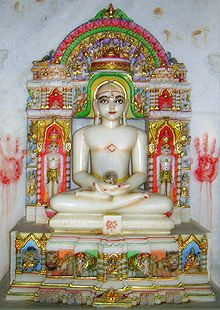- Munisuvrata
-
Munisuvrata 20th Jain Tirthankara
Idol of Munisuvrata Swami, SanthuDetails Alternate name: Munisuvrat Swami Historical date: 1,184,980 BCE Family Father: Sumitra Mother: Padmavati Dynasty: Harivamsha Places Birth: Kusagranagara (Raj-grih) Nirvana: Sammet Shikhar Attributes Colour: Black Symbol: Tortoise Height: 20 dhanusha (60 meters) Age At Death: 30,000 years old Attendant Gods Yaksha: Varun Yaksini: Nardatta Jainism
This article is part of a series on JainismPrayers and Vows Ṇamōkāra mantra · Ahimsa · Brahmacharya · Satya · Nirvana · Asteya · Aparigraha · Anekantavada · Parasparopagraho Jīvānām Key concepts Kevalajñāna · Cosmology · Samsara · Karma · Dharma · Moksha · Gunasthana · Navatattva Major figures The 24 Tirthankaras · Rishabha · Mahavira · Acharya · Ganadhara · Siddhasena Divakara · Haribhadra Jainism by region India · Europe · United States · Canada Sects Śvētāmbara · Digambara · Svetambar Terapanth · Sthānakavāsī · Bhattaraka · Murtipujaka Texts Kalpa Sūtra · Āgama · Tattvartha Sutra · Sanmatti Prakaran Other Festivals Paryushana · Diwali
Jainism Portal
Munisuvrata Swami (मुनिसुव्रत स्वामी) was the twentieth Jain Tirthankar of the present age (Avasarpini).[1] According to Jain beliefs, he was born around 1,184,980 BCE. He became a siddha, a liberated soul which has destroyed all of its karma. Munisuvrata was born to King Sumitra Raja and Queen Padmavati Rani at Mithila in the HariVansh clan.[1] His birth date was the 15th day of the Shravan Sukla month of the Indian calendar.
The being that was to be Bhagavan Munisuvrat purified its soul during his birth as Surshreshta, the king of Champa city in Mahavideh. He then reincarnated in the Pranat dimension of gods.[2]
Contents
Life as a Tirthankara
King Sumitra of the Harivamh clan ruled over Rajgriha town. His wife, queen Padmavati, gave birth to a son, the being that had descended from the Pranat dimension of gods, on the ninth day of the dark half of the month of Jyeshta. After the traditional post birth rituals the name giving ceremony was celebrated. The king announced that since this being had descended into the womb of queen Padmavati, she took a variety of good vows and lead a life as disciplined as an ascetic. As such the new born named Munisuvrat (vow like ascetics).
In due course Munisuvrat was married and ascended the throne. After a successful and long reign he became an ascetic on the eighth day of the dark half of the month of Phalgun. He wandered as an ordinary ascetic for eleven months and attained omniscience under a Champa tree. His first discourse was on the subject of "scriptural and applied philosophy". After a long life devoted to spread of true religion he went to Sammetshikhar and got liberated on the ninth day of the dark half of the month of Jyeshtha.[3]
Bhagavan Munisuvrat’s period was an important period of Jain pre-history. His illustrious contemporaries and followers included stalwarts like the ninth Chakravarti-Mahapadma, the eighth Prativasudev, Baldev, and Vasudev, Ravan, Rama and Lakshman respectively. The elder brother of Bahagavan Munisuvrat, ascetic Vishnu Kumar, also became famous for his pioneering effort of saving the Jain organization from the oppressions of mister Namuchi; the Raksha Bandhan festival is celebrated in the memory of that event.[4]
Shani and Lord Munisuvarat (20th jain tirthankar)
One who prays to Lord Munisuvarat is protected from Shani as he is great devotee of Lord Munisuvarat Swami (20th jain tirthankar) as per Jainism and really one can trace from ancient times people worshiping Munisuvarat Swami whose symbol is Tortoise to get protected from ill effects of not properly placed shani in ones horoscope.
Usually Munisuvarat Swamis idol is always found made up of Black colour. Millions of devotees across the world have witnessed miracles of Munisuvarat swami.
At Kankali Tila in Mathura a deity of Muni-Suvrat Swami whose insignia is tortoise, was discovered. One of the nude statues in Mohan-Jodaro (Indus Valley ) has the tortoise insignia, which indicates that it must be of Muni-Suvrat Swami. In Vedic history there are descriptions of a Muni in the Puran, connected to the tortoise, which throws light on Muni Suvrat. In the Rigved (23, 27, 32) a sage with tortoise insignia has been mentioned which is none other than Tirthankar Muni-Suvrat Swami. It connection with the tortoise the Puran (40, 27, 41) writes that Vishnu appeared in the form of tortoise in Rishabh race ( First Tirthankar).
See also
References
- ^ a b Tukol, T. K. (1980). Compendium of Jainism. Dharwad: University of Karnataka. p.31
- ^ Helen, Johnson (2009) [1931]. Muni Samvegayashvijay Maharaj. ed (in English. Trans. From Prakrit). Trisastiśalākāpurusacaritra of Hemacandra: The Jain Saga. Part II. Baroda: Oriental Institute. ISBN 978-81-908157-0-3. p.294
- ^ Helen, Johnson (2009) Part II pp.295-306
- ^ Helen, Johnson (2009) Part II pp.307-499 Note: Story of Lord Munisuvrata also contains the stories of Rama and Lakshmana and Jain version of Ramanaya
Rishabha or Adinath • Ajitnath • Sambhavanath • Abhinandannath • Sumatinath • Padmaprabha • Suparshvanath • Chandraprabha • Pushpadanta • Sheetalnath • Shreyansanath • Vasupujya • Vimalnath • Anantnath • Dharmanath • Shantinath • Kunthunath • Aranath • Mallinath • Munisuvrata • Naminatha • Neminatha • Parshva • MahaviraCategories:- Tirthankars
- Jainism in Mithila
Wikimedia Foundation. 2010.


